The original half-dreadnoughts:
The 薩摩型戦艦 Satsuma-gata senkan class was ordered in late 1904, under the War Naval Supplementary Program established during the Russo-Japanese War. It could have been a simple follow-up of previous battleships, but in reality the Satsuma were a clear departure from the Katori-class pre-dreadnoughts. They were the first Japan-built battleships, and perhaps the best examples of a “semi-dreadnought”.
What is a half-dreadnought ?
The last generation of “pre-dreadnought” were launched when the revolutionary HMS Dreadnought was not even laid down. Many naval staff around the world already had an idea od an “all big gun” concept. This was no secret indeed as the “trend” was already in the air and in discussion throughout naval academies, between engineers and naval think tanks. It could be traced back to V. Cuniberti famous publication in Jane’s 1903. His drawing was of a 12-in armed “super-armoured cruiser”, combining speed and heavy armament. It was just scaled up to give the new generation of battleships. But the 1904-1907 period saw in battleship-producing countries the ultimate generation of battleships, all adopting a powerful secondary battery, just below the main one in caliber. The idea was this secondary artillery being almost as good in range, but faster and in larger quantities than the main guns could provide a substantial punch during the slow reload of the main battery, using HE shells while the main guns used AP ones, however not always diverging in caliber enough to have the water plumes not mismatched by the fire control observers.
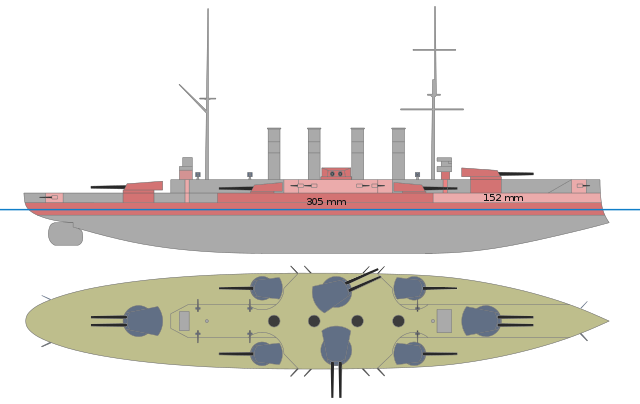
Cuniberti’s peculiar artillery arrangement design was the one chosen by the Japanese engineers, not the simpler configuration retained on HMS Dreadnought.
In addition these secondary guns were in turrets, just like the main guns while the former secondary battery, now tertiary, comprised barbette guns, between 120 and 178 mm, 150 or 6-in rapidly becoming the standard. The latter role was to engage closer, smaller and faster targets, destroyers and light cruisers. So in the end, an entire generation of late pre-dreadnought sometimes called “hybrid” battleships appeared: The Nelson (UK), Danton (France), Mississippi (US), and Regina Elena (Italy), and of course, the Satsuma. Perhaps the last two were the closest to the concept of ‘half-dreadnoughts’, which is both a simplistic and misguiding term. They had a powerful secondary turret battery, but also speed to match, but yet were not true ‘dreadnoughts’.
Development of the Satsuma design
The original all-big-gun battleships
The Satsuma class evolved since they were ordered in late 1904 but narrowly missed the title of true dreadnoughts:
Indeed, Japan at that time was very close to the Royal Navy in doctrine, training, as well as shipbuilding and equipments. This was conpounded by a naval alliance treaty in 1902, just two years prior. It was very clear that the IJN staff knew some of the “secrets” projects in development in the Royal Navy and in particular the pet project of Admiral Fisher, the HMS Dreadnought.
Therefore it seemed seductive of this first purely Japanese battleship to be at the same time the First Japanese dreadnought. And indeed the Satsuma originally intended to mount a dozen 12-inch (305 mm) gun in four twin and four single-gun turrets, one turret forward and aft, two on the beam, and two in between each broadside, narrower.
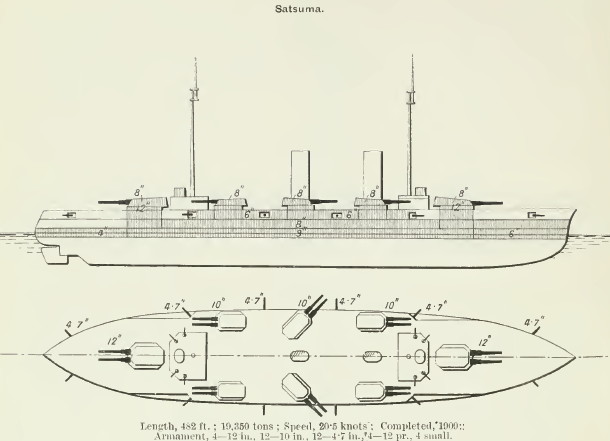
But theere were two obstacle to these plans: A shortage of Japanese-built 12-inch guns, and the additional expenses associated. This caused the designer to get back to only four 12-inch while the secondary battery was raised to twelve 10-inch (254 mm) guns, all in twin-mount turrets. The original armament as laid down even before HMS Dreadnought, would have made them the first “all big-gun” battleships worldwide and the whole new capital ship breed would not have been called “dreadnought” at all.
The world’s best pre-dreadnoughts ?
Instead, with a reference to the British Lord Nelson class in mind, the design was revised by integrating the three amidships intermediate turrets. These were 10 in (254 mm) guns, for a heavy broadside. This powerful intermediate armament made them considered as ‘semi-dreadnoughts’, transitional in-between two types. In comparison, the Italian Regina Elena class were armed with less 12-in guns and small caliber (8-in) guns instead, but the Satsuma conceded two knots to them while they were better protected. This placed them closer in fact to the Nelson (same battery) and the Danton, armed with 240 mm guns, but the Aki (1907) was faster than the two. All in all they were perhaps the best pre-dreadnought worldwide when completed.
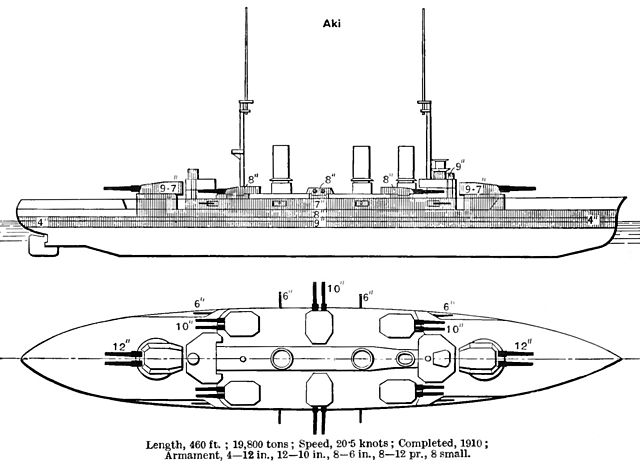
IJN Aki diagram – Brasseys 1923
Design
It should be noted that both battleships diverged (Satsuma and Aki). The latter was launched in Kure nearly a year later in March 1906 (May 1905 for Satsuma at Yokosuka), and delayed, waiting for the slipway occupied by the Tsukuba was freed. This gave the opportunity to modify the ship, accommodating steam turbines and many other changes, to the point Aki is sometimes considered a single ship, not a sister-ship. The crew comprised 800 to 940 officers and enlisted men in wartime. Satsuma was 482 feet (146.9 m) long by 83.5 feet (25.5 m), and 27.5 feet (8.4 m) of draught.
Displacement was 19,372 long tons (19,683 t) while Aki was 20,100 long tons (20,423 t) at normal load. Aki was also longer at 492 feet (150.0 m). It should be noted than although “Japanese” in construction, both ships still heavily depended on foreign purchases: 61% of the new battleship was made in imported steel, the guns were British as well as the sighting and targeting equipments, rangefinders and control devices. On Aki, the turbines were American curtis models.
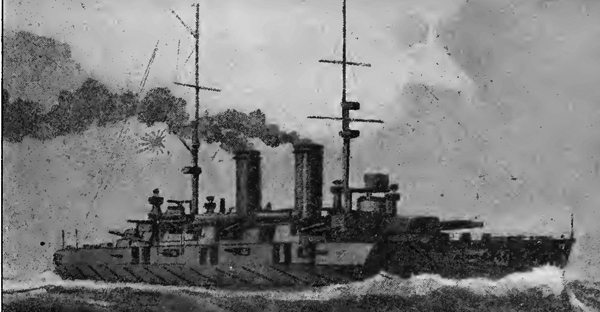
Powerplant
Satsuma was given a classic pair of vertical triple-expansion steam engines. They were fed by the steam generated by 20 Miyabara water-tube boilers. These were mixed boilers firing a mixture of coal and fuel oil. The entire output was rated at 17,300 indicated horsepower (12,900 kW). On specifications, top speed was estimated to 18.25 knots (33.80 km/h; 21.00 mph). On sea trials however, Satsuma went beyond and reached 18.95 knots (35.10 km/h; 21.81 mph) at 18,507 ihp (13,801 kW). Satsuma carried 2,860 long tons (2,910 t) of coal, 377 long tons (383 t) of oil, enough to cruise about 9,100 nautical miles (16,900 km; 10,500 mi) at 10 knots and could be recoignised from her sister by her two funnels.
Aki on the other hand, was built later and this allowed to scrap the original VTE design and try for the first time Curtiss steam turbine sets instead. They were placed inside after she was launched in 1907. These turbines were fed by the steam from 15 Miyabara boilers, rated at 24,000 shaft horsepower (18,000 kW). Designed speed was 20 knots (37 km/h; 23 mph), but Aki reached 20.25 knots (37.50 km/h; 23.30 mph) in sea trials (27,740 shp). She also carried more coal, 3,000 long tons (3,000 t) but less oil, 172 long tons, for the same range.
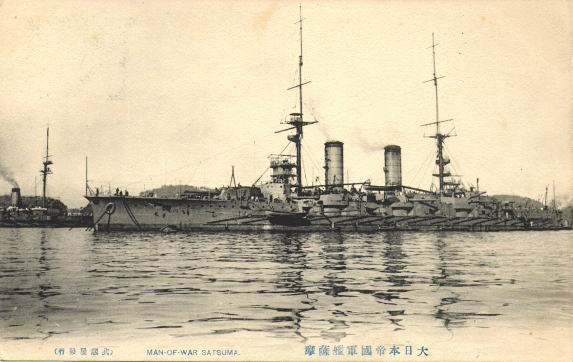
Armament
Although both ships had the same main and secondary battery, they diverged for their tertiary artillery. The four 45-caliber (12 in) 41st Year Type guns in twin turrets were placed fore and aft of the superstructure, like the original design. They used a 850-pound (386 kg) armor-piercing (AP) shell, existing the muzzle at 2,800 ft/s (850 m/s). Range was 24,000 yards (22,000 m). The intermediate armament comprised six twin-gun turrets, each carrying the 45-caliber Type 41 10 in guns. Theur muzzle velocity was less, at 2,707 ft/s (825 m/s), firing 500-pound (227 kg) shells. However their effective range was 26,900-yard (24,597 m) at 30° elevation, even better than the main guns, allowing concentrated fire without distinguishing much between the calibers.
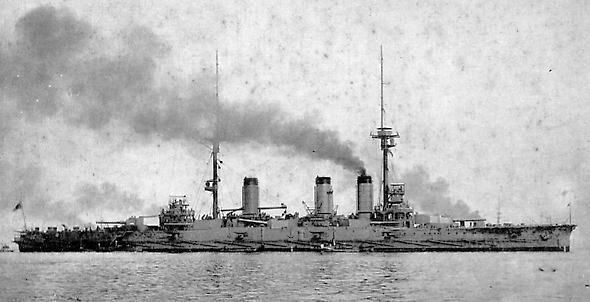
Battleship Aki, profile view.
The tertiary armament however differed considerably between the two half-sisters: Aki had eight 45-caliber 6 in (152 mm) 41st Year Type guns in side casemates in the hull. Each fired a 100-pound (45 kg) AP shell at 2,706 ft/s (825 m/s) at a range of 14.8 km (9.2 mi) at 18 degree elevation. Satsuma however was given instead twelve smaller guns, 40-caliber 4.7-inch 41st Year Type quick-firing (QF) models also in side casemates. Each fired a 45-pound (20 kg) shell at 2,150 ft/s (660 m/s). This was the archetypical light Elswick Ordnance caliber.
Divergences went on with four 12-pounder/40 12-cwt QF guns (Satsuma) or eight on the Aki, four 12-pounder/28 QF guns which fired the standard 12.5-pound (5.67 kg) shell at 2,300 ft/s (700 m/s) down to 1,500 fps (450 m/s) and fitted with five submerged 18 in (457 mm) torpedo tubes (broadside and stern).
Protection
Certainly not sacrificed but less impressive than on Russian battleships, Satsuma and Aki’s protection scheme were almost similar. On Satsuma, a waterline main belt was made of Krupp cemented armor reaching 9 in (229 mm) amidships, tapering down to 4 inches (102 mm). Casemates were 6-inch (152 mm) thick and main turret barbettes were 7–9.5 in (180–240 mm). The main gun turrets frontal arc was protected by only 8-in (203 mm), raised on Aki to 9 in (241 mm). Deck armor remained the same at 2–3 in (51–76 mm) while the conning tower had 6-in walls (152 mm).
The Satsuma in action
The completion of the HMS Dreadnought in 1906 of course made the latest IJN battleships obsolete before completion. In fact it was the last of that kind as the next naval plan ‘8-8’ included first-class (dreadnought) battleships and eight battlecruisers in 1910. Therefore the Satsuma were not intended for a long service by any measure. Aki was refitted at Kure and Satsuma just joined 1st Battleship Squadron when war broke out in August 1914. Satsuma was Tatsuo Matsumura’s flagship (Second South Seas Squadron) started with the attack of German possessions in the Caroline and the Palau Islands, then 1st Battleship Squadron in 1915, refitting at Sasebo. Aki also joined the 1st Squadron after refit for most of the war, then she joined the 2nd Battleship Squadron in 1918. The Washington Naval Treaty signed in February 1922 imposed tonnage limits on Japan, which decided against all of her obsolete pre-dreadnought and unique semi-dreadnoughts (Aki and Satsuma) as well. Consequentely they were to be disposed in 1924, disarmed, stricken and converted into target ships.
IJN Satsuma’s career
Named after the traditional Satsuma Province, the Japanese “semi-dreadnought” was built at Yokosuka Naval Arsenal, started in May 1905, launched on 15 November 1906, completed on 25 March 1910. This was a massive ships and when launched, before the Dreadnought, she was the largest warship afloat, with the largest displacement. Soon into service, on 5 August 1911, IJN Satsuma suffered an explosion in a 12-inch gun. The latter misfired during gunnery practice and the gunnery officer in charge decided after some time passed, he ordered the breech to be opened. This unfortunate move had the effect to provoke a rush of air and and ignited the propellant. The blast killed 16 crewmen and several officers inside the turret and barbette. After repairs, Satsuma resumed service.
She was caught in a typhoon on 22 September 1912, but lightly damaged and repaired quickly. Next, she was just assigned to the 1st Battleship Squadron in August 1914. She hoisted the flag of Rear Admiral Tatsuo Matsumura in the Second South Seas Squadron. The latter was tasked to seize German possessions of the Caroline and the Palau Islands in October. IJN Satsuma returned to the 1st Battleship Squadron in 1915. She was refitted at Sasebo Naval Arsenal the next year in 1916, and then joined the 1st Squadron for the remainder of the war. During this refit or later, she was fitted with two 12-pounders guns (76 mm). They were placed on high-angle mounts and acted as anti-aircraft guns.
Satsuma was disarmed at Yokosuka Naval Arsenal in 1922, to comply with the The Washington Naval Treaty. She was stricken from the Navy List on 20 September 1923. It was decided to convert her into a target ship. In operation she was sunk by the battleships Mutsu and Nagato, sinking off the southern tip of the Bōsō Peninsula (mouth of Tokyo Bay) on 7 September 1924.
IJN Aki’s career
Aki was laid down at Kure Naval Arsenal on 15 March 1906, launched on 15 April 1907. However, as explained above, construction was suspended for five months and decision was made on 26 November to install steam turbines the armored cruiser Ibuki (also almost a “semi-battlecruiser”). Aki’s turbines however fell behind schedule. This suspension allowed less valuable ship to be completed before. Changes to the turbines after testing them ended on Aki’s turbines as well. Completion was effective on 11 March 1911. Shge entered service with captain was Tatsuo Matsumura.
In August 1914, IJN Aki was refitting at Kure Naval Arsenal. She joined the 1st Battleship Squadron and remained with this unit in the home islands virtually until the end of the war. Her career was made of fleet exercises without notable even or incident. December 1915 – December 1916 saw her with a new captain, Kiyokazu Abo. At last, she was transferred to the 2nd Battleship Squadron in 1918. The war ended as she never fired a short in anger, contrary to Satsuma which operated against German possessions.
She was disarmed at Yokosuka in 1922 in conformity to the Washington Naval Treaty. She was stricken in 1923 and like Satsuma, converted into a target ship.
IJN Aki was eventually sunk by battlecruisers Kongō and the battleship Hyūga on 2 September 1924, in Tokyo Bay.
Like Satusma also, her guns were removed and transferred to the Imperial Japanese Army. The mounts, breechblocks and barrels were controlled and revised, ending in several coastal fortifications along strategic points. The rest were placed in reserve. Without use, they wete scrapped in 1943. Two of her smaller 10-in guns however were installed in the coastal batteries on Jōgashima island. They covered the entrance of Tokyo bay.
Satsuma specifications 1914 |
|
| Displacement: 15 400t Fully Loaded | |
| Dimensions: 137.2 x 23 x 8 m | |
| Propulsion: 2 shafts VTE, 20 Miyabara boilers, 20,500 hp, 20.5 knots | |
| Armour: Belt 203 mm, see notes | |
| Crew: 844 | |
| Armament: 4 x 305, 12 x 254, 12 x 120 (Satsuma), 4 x 45 mm, 2 x 40 mm AA, 3 TT 457mm sub. | |
Sources/read more
http://www.avalanchepress.com/Semi-Dreadnoughts.php
https://www.hazegray.org/navhist/battleships/ijn_dr.htm
http://navypedia.org/ships/japan/jap_bb_satsuma.htm
naval-encyclopedia.com/ww1/pages/japan/marine_jap1914c.htm
https://en.wikipedia.org/wiki/Satsuma-class_battleship
https://www.globalsecurity.org/military/world/japan/satsuma-bb.htm
https://sites.google.com/site/davidijn/home
Book: Battleships: An Illustrated History of Their Impact
Satsuma Class Battleships Books LLC Amazon
Rober Gardiner’s Conway’s all the world’s fighting ships 1906-1921 & 1865-1905
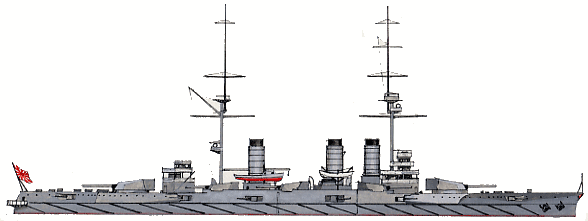
Illustration of the IJN Aki (three funnels) by the author


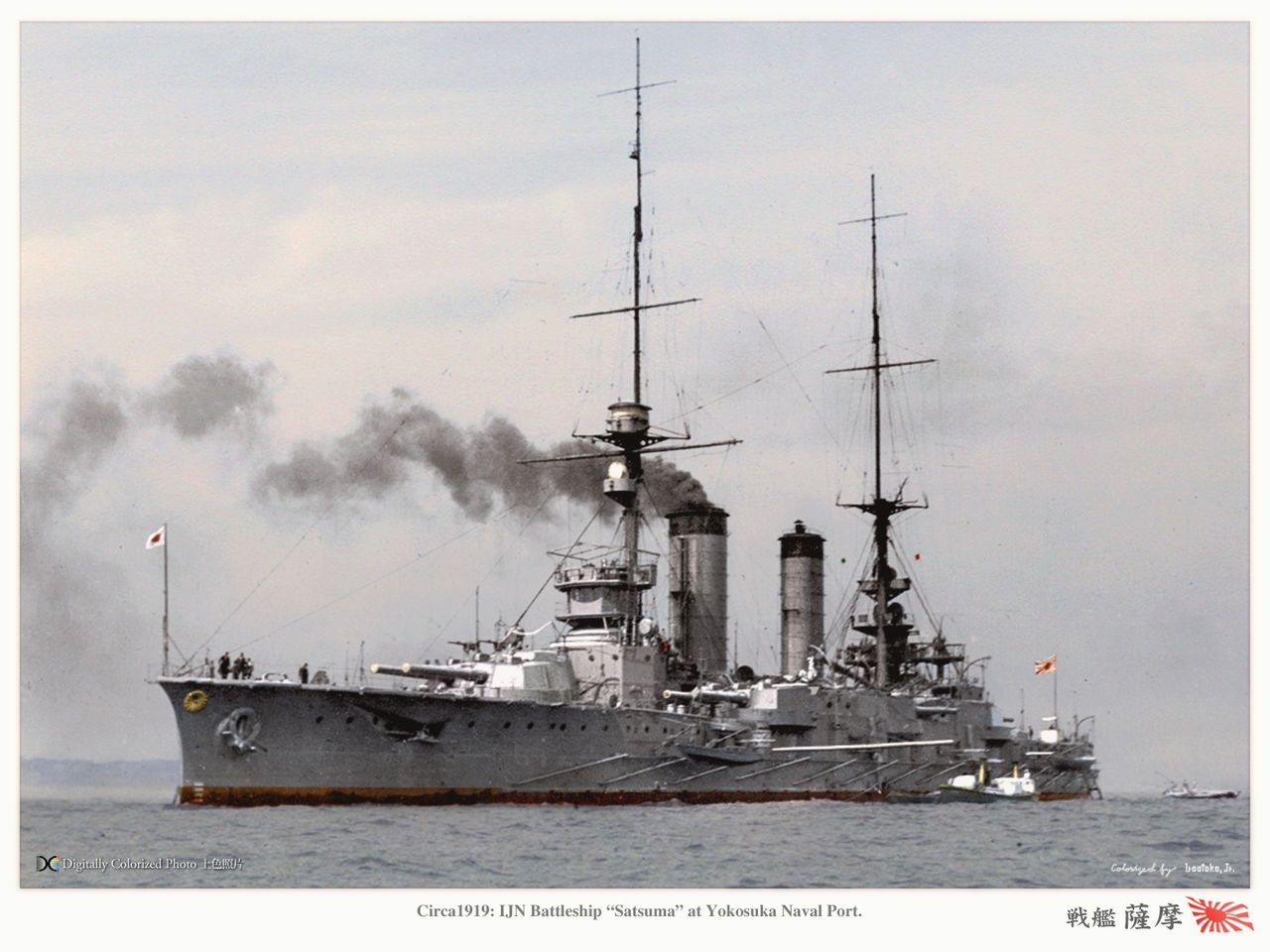
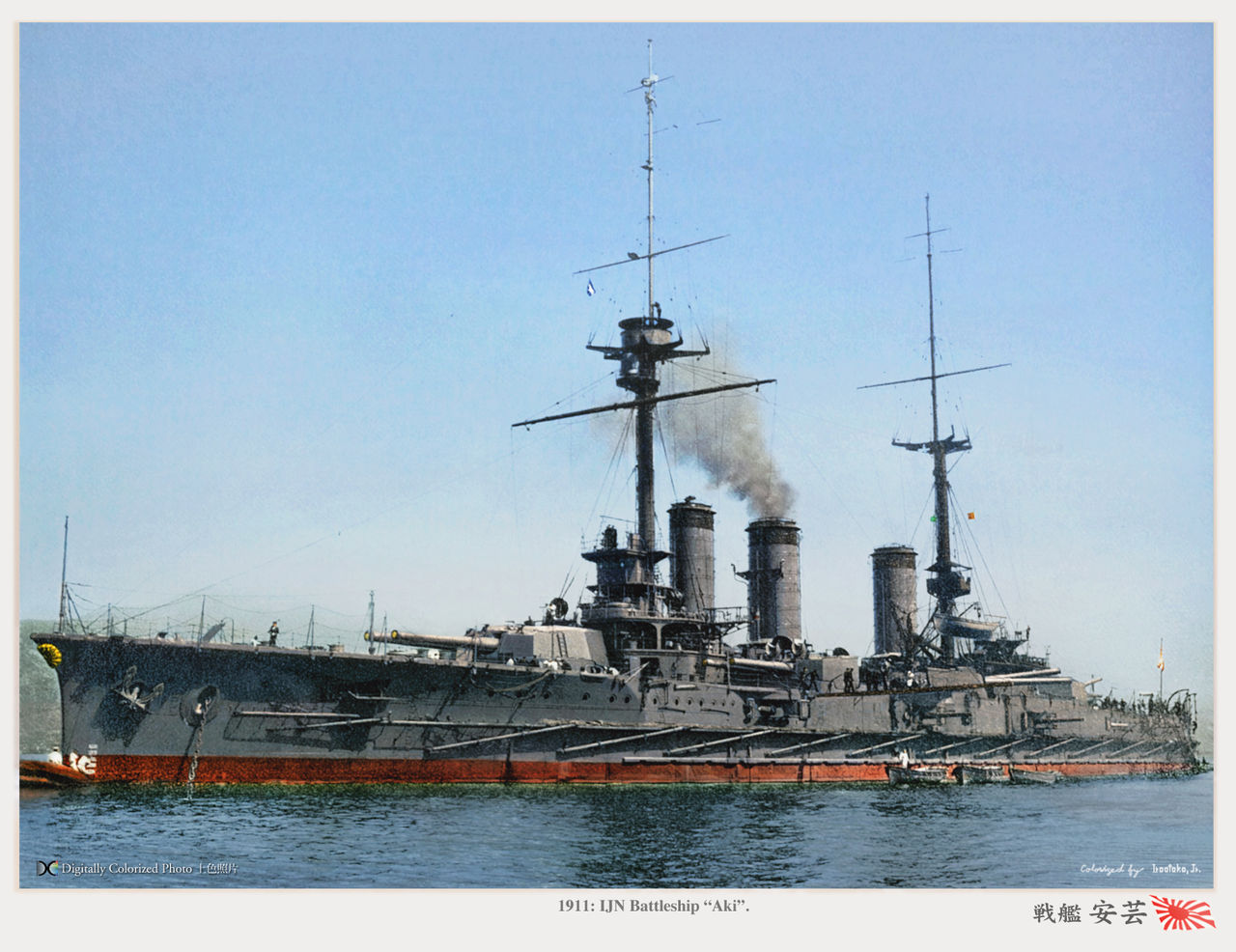
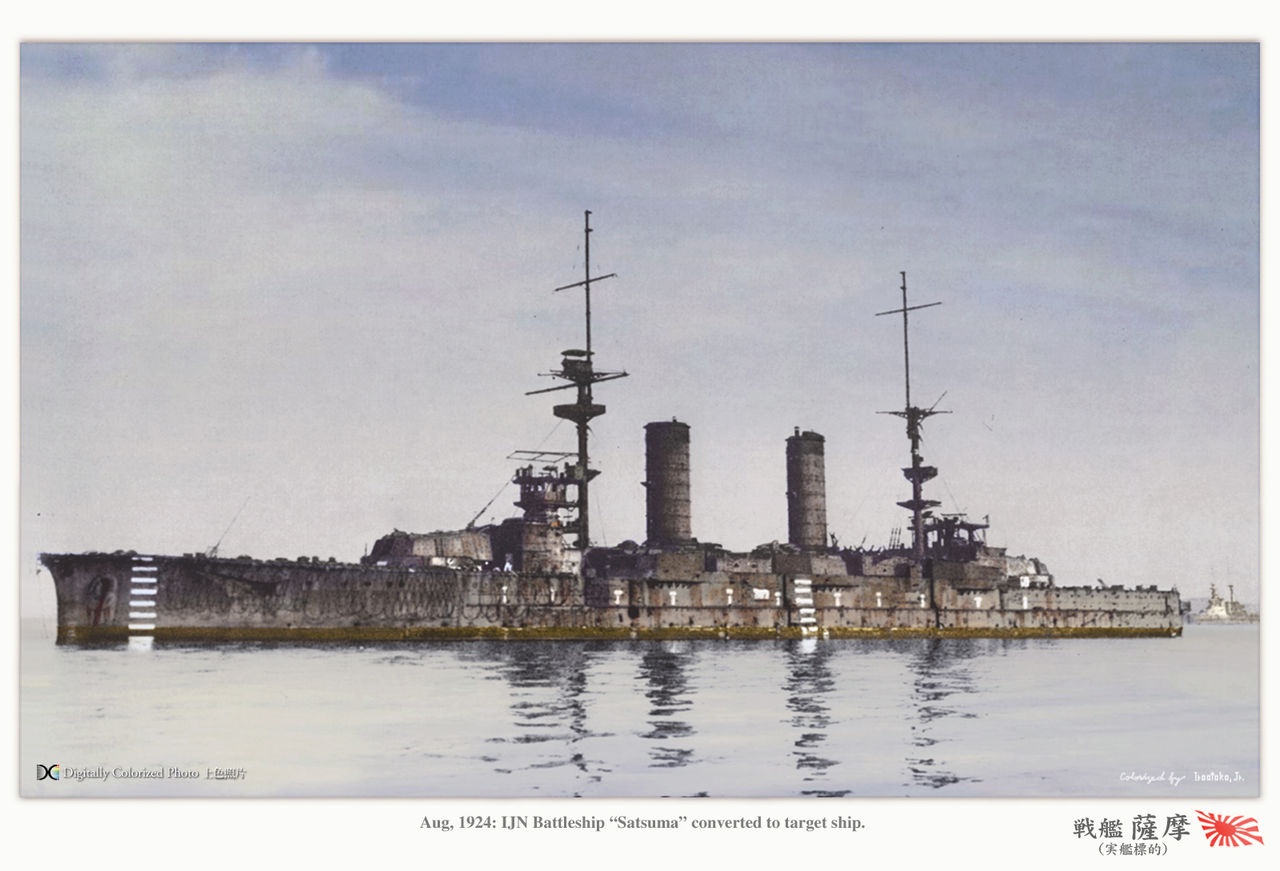
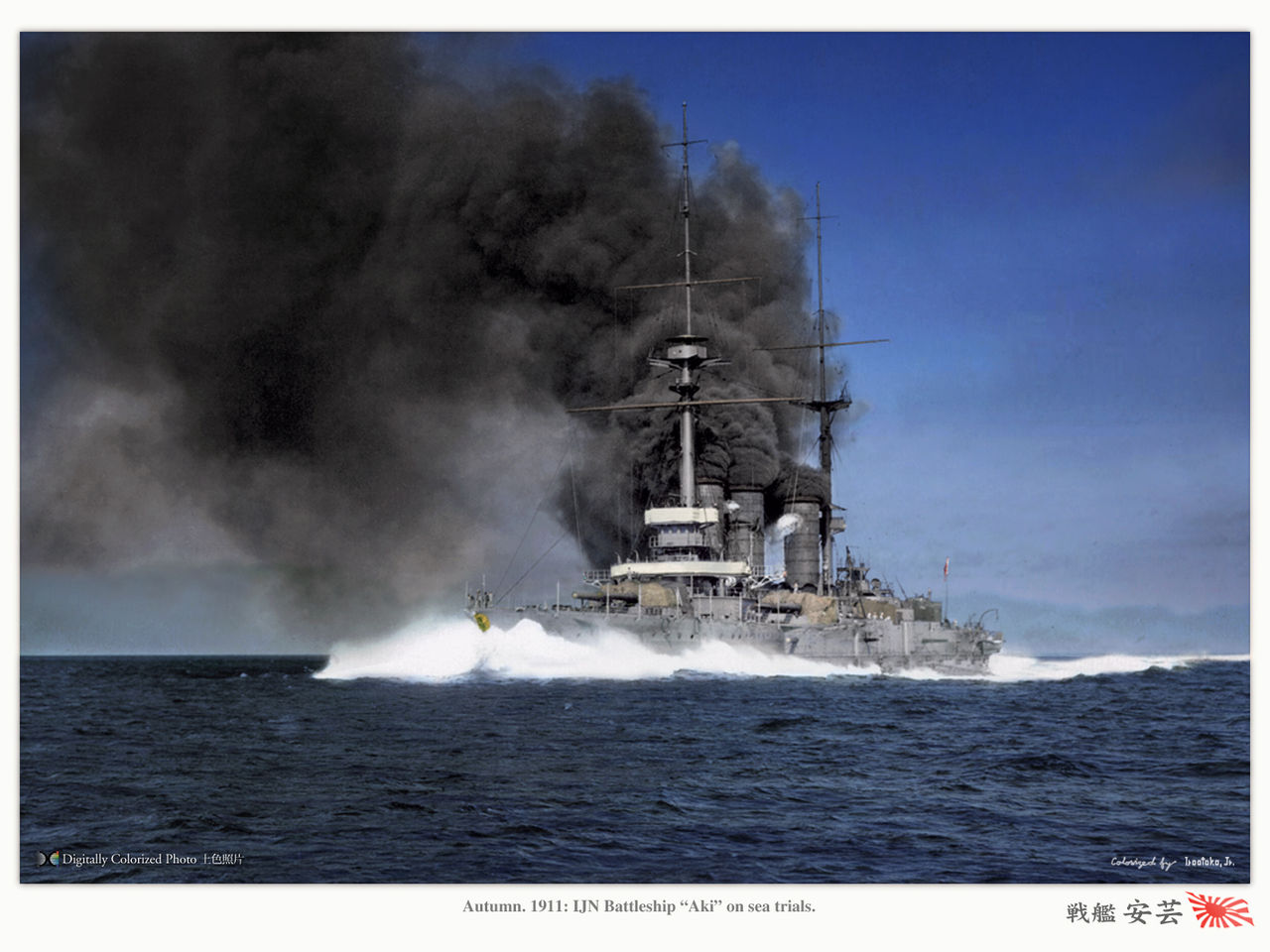
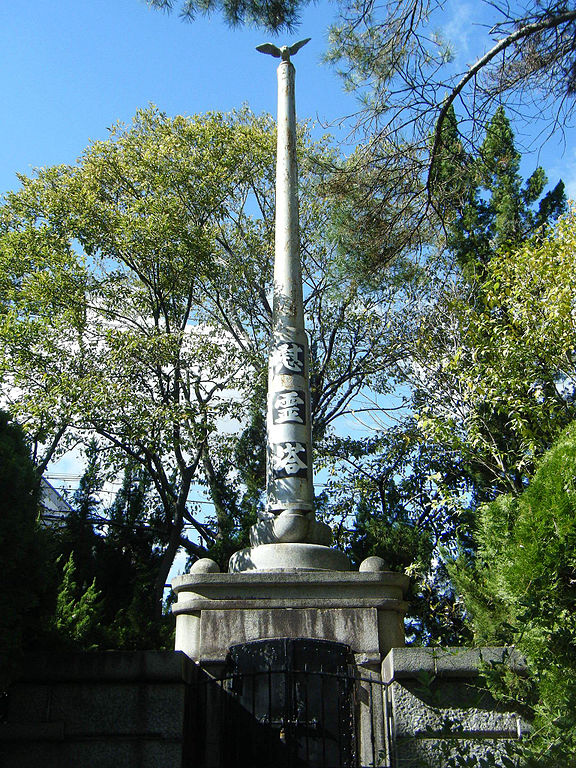
 Latest Facebook Entry -
Latest Facebook Entry -  X(Tweeter) Naval Encyclopedia's deck archive
X(Tweeter) Naval Encyclopedia's deck archive Instagram (@navalencyc)
Instagram (@navalencyc)





 French Navy
French Navy Royal Navy
Royal Navy Russian Navy
Russian Navy Armada Espanola
Armada Espanola Austrian Navy
Austrian Navy K.u.K. Kriegsmarine
K.u.K. Kriegsmarine Dansk Marine
Dansk Marine Nautiko Hellenon
Nautiko Hellenon Koninklije Marine 1870
Koninklije Marine 1870 Marinha do Brasil
Marinha do Brasil Osmanlı Donanması
Osmanlı Donanması Marina Do Peru
Marina Do Peru Marinha do Portugal
Marinha do Portugal Regia Marina 1870
Regia Marina 1870 Nihhon Kaigun 1870
Nihhon Kaigun 1870 Preußische Marine 1870
Preußische Marine 1870 Russkiy Flot 1870
Russkiy Flot 1870 Svenska marinen
Svenska marinen Søværnet
Søværnet Union Navy
Union Navy Confederate Navy
Confederate Navy Armada de Argentina
Armada de Argentina Imperial Chinese Navy
Imperial Chinese Navy Marinha do Portugal
Marinha do Portugal Mexico
Mexico Kaiserliche Marine
Kaiserliche Marine 1898 US Navy
1898 US Navy Sovietskiy Flot
Sovietskiy Flot Royal Canadian Navy
Royal Canadian Navy Royal Australian Navy
Royal Australian Navy RNZN Fleet
RNZN Fleet Chinese Navy 1937
Chinese Navy 1937 Kriegsmarine
Kriegsmarine Chilean Navy
Chilean Navy Danish Navy
Danish Navy Finnish Navy
Finnish Navy Hellenic Navy
Hellenic Navy Polish Navy
Polish Navy Romanian Navy
Romanian Navy Turkish Navy
Turkish Navy Royal Yugoslav Navy
Royal Yugoslav Navy Royal Thai Navy
Royal Thai Navy Minor Navies
Minor Navies Albania
Albania Austria
Austria Belgium
Belgium Columbia
Columbia Costa Rica
Costa Rica Cuba
Cuba Czechoslovakia
Czechoslovakia Dominican Republic
Dominican Republic Haiti
Haiti Hungary
Hungary Honduras
Honduras Estonia
Estonia Iceland
Iceland Eire
Eire Equador
Equador Iran
Iran Iraq
Iraq Latvia
Latvia Liberia
Liberia Lithuania
Lithuania Mandchukuo
Mandchukuo Morocco
Morocco Nicaragua
Nicaragua Persia
Persia San Salvador
San Salvador Sarawak
Sarawak Uruguay
Uruguay Venezuela
Venezuela Zanzibar
Zanzibar Warsaw Pact Navies
Warsaw Pact Navies Bulgaria
Bulgaria Hungary
Hungary

 Bundesmarine
Bundesmarine Dutch Navy
Dutch Navy Hellenic Navy
Hellenic Navy Marina Militare
Marina Militare Yugoslav Navy
Yugoslav Navy Chinese Navy
Chinese Navy Indian Navy
Indian Navy Indonesian Navy
Indonesian Navy JMSDF
JMSDF North Korean Navy
North Korean Navy Pakistani Navy
Pakistani Navy Philippines Navy
Philippines Navy ROKN
ROKN Rep. of Singapore Navy
Rep. of Singapore Navy Taiwanese Navy
Taiwanese Navy IDF Navy
IDF Navy Saudi Navy
Saudi Navy Royal New Zealand Navy
Royal New Zealand Navy Egyptian Navy
Egyptian Navy South African Navy
South African Navy






























 Ukrainian Navy
Ukrainian Navy dbodesign
dbodesign
I wonder how these ships would have faired against first dreadoughts? Both had 4 X 12 inch guns fore and aft. On the sides the intermediates had 6 X 10 inch guns with less range and lighter shells but a higher rate of fire. The dreadnoughts had 4 X 12 inch guns to each side with greater range and amour penetration firing heavier shells at a slower rate plus there are ony 4 guns. In addition the intial generation dreadnoughts did not have a centralized fire control system. This was quickly rectified by 1914. However the amour was not very heavy on these early ships either. They followed a graduated amour approach like the pre dreadboughts. This was corrected on later classes but could not be changed on the early ships. A battle between these ships would have been most
Speculation, speculations… But interesting points nonetheless. Indeed in terms of naval duels, apart Jutland, WWI was a show of cruisers (from battlecruisers to light ones), not battleships. So who knows.